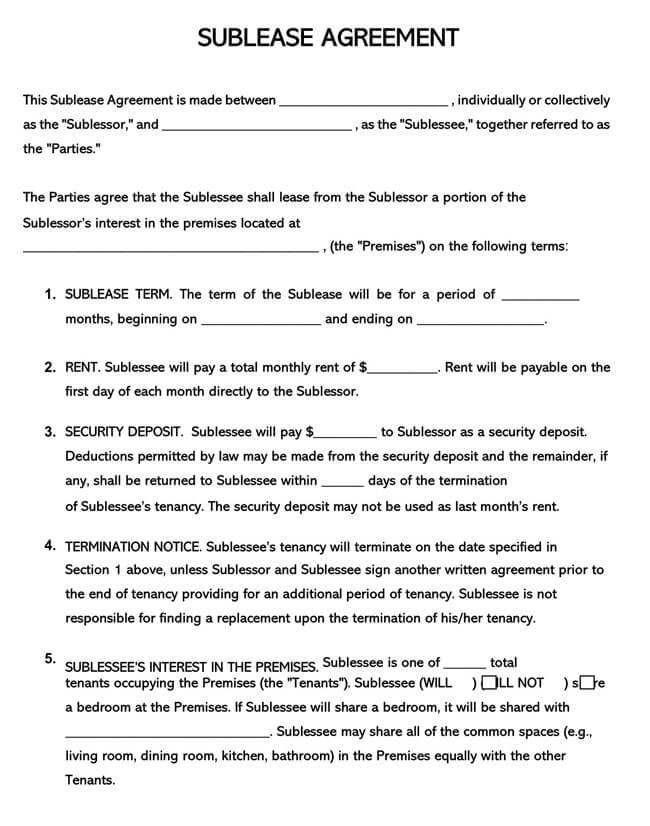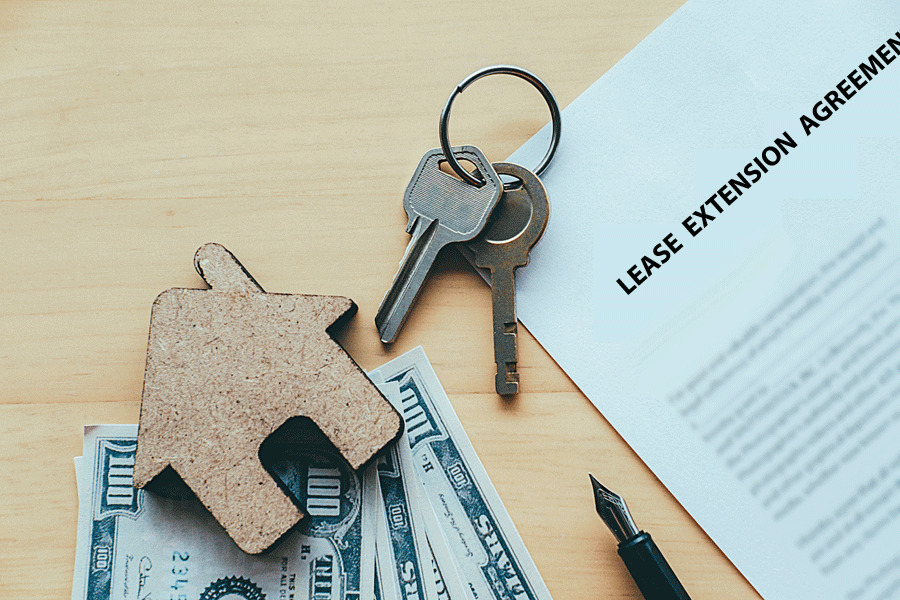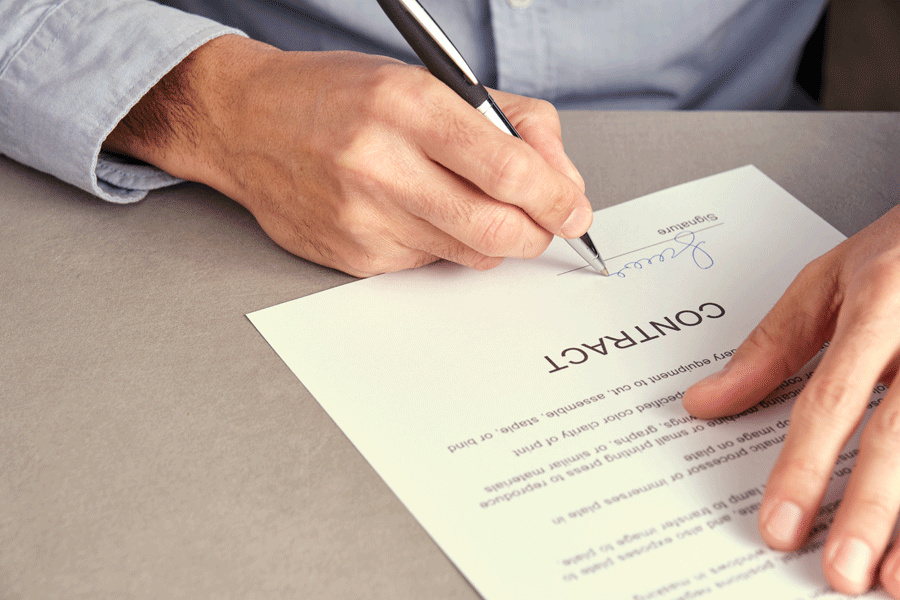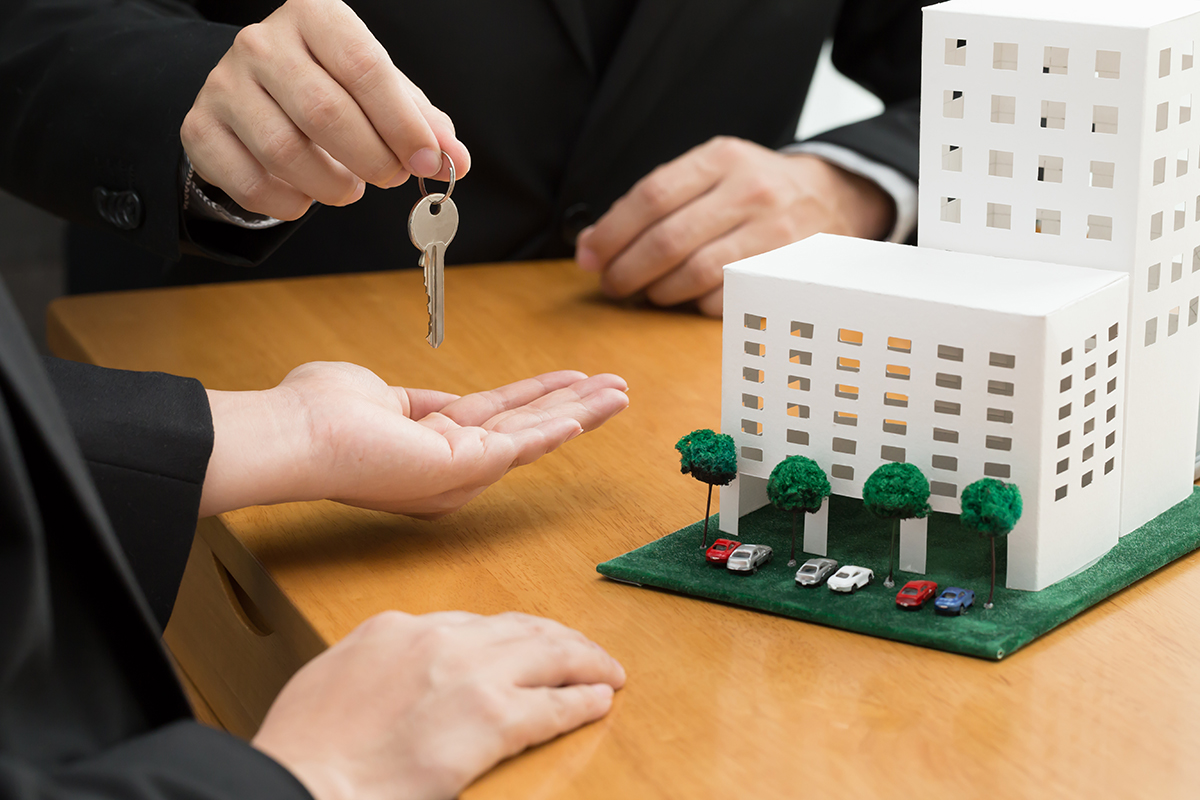Sublease agreement is a contract between a tenant (sublessor/sublandlord) of an existing lease and a new tenant (sublessee/subtenant).
The subtenant is obligated to follow the terms and conditions of the original lease; however, the original tenant remains singly responsible for payment of rent, damages, and any breach of the original lease agreement. A sublease cannot exceed the original lease term.
Formally we define it as:
It is used when tenants want to sublet a portion or all of rented spaces/property.
Other alternate names of it are:
- Sublease contract
- Sublet contract
- Sublease
- Sublease rental agreement
Subleasing is common in various situations. For example, when a person renting an apartment has to relocate between their lease terms temporarily, they want to hold on to space. Hence, they opt to find a third-party responsible for paying rent during this period. Sometimes tenants may find themselves with excess space or a room to spare and seek out a sublessee to chip in with rent payments. All the parties involved; sublandlord and subtenant should sign the agreement and keep a signed copy.
Free Sublease Agreement Templates
Standard template

By state
Types of Properties to Sublet
Subleasing is not limited when it comes to residential property. One can sublet a house, apartment, or condo as long as the landlord is aware and approves of the transaction. Additionally, a tenant can opt to sublet a portion of the premises, such as a single room or multiple rooms, garage/storage space, or a basement suite.
Process of Subleasing
Subleasing is considered a convenient option for a tenant. There are several steps that you can refer to when undergoing this process. We shall look into these steps one after the other:
Allowance of subleasing
Firstly, a sublessor must identify if their lease agreement or landlord permits subleasing. There is that provision in the original agreement in some cases, but sometimes it might not be. If the lease agreement does not allow subleasing, do not give up yet, for through reaching out to your landlord, your wish of subleasing might still be in your hand.
If subleasing is allowed in the initial lease agreement, one should follow the instructions guiding on how it was agreed to be handled. In some cases, the process will only require informing the landlord of the intention to sublet, while others require introducing the new tenant to the landlord.
If subleasing is not permitted, one can contact the landlord, informing them of their situation to convince them to allow it. Most landlords are against subleasing as the sublessor cannot guarantee that the new tenant will follow initially agreed-upon property rules. However, assuring the landlord that the subleasing will follow due diligence and the sublandlord is still obligated to make rent payment and liable for damages can influence the landlord’s decision to allow subleasing. Also, it is recommended that a draft of this agreement is sent to the landlord for review and confirmation that pertinent details were included.
Find a tenant
Once the landlord has approved the sublease, the next step should be to find a suitable tenant. Finding a fit can be pretty demanding, and as a result, a lot of care and precaution should be taken at every stage of the process. The easiest subleases, if available, are ones that you know personally, such as a friend or relative.
Other ways of finding tenants include:
- Online postings: A sublessor can post the ad on some of the available online platforms. Through these platforms, one can filter out potential tenants to protect themselves from unsuitable sublessees.
- College/university boards: The other option is to advertise the availability of space through printed flyers around popular common areas within and around the campus. These include boards in common rooms, cafeterias, dorms, etc., information to be included in the flyer is a picture of the space, the monthly rent, and contact information. Students looking for places to live during summer will often look for openings in these areas.
- Social media: Alternatively, one might opt to look for tenants through social media such as Facebook. Posting the property’s availability and other pertinent details can attract potential clients. People’s profiles and posts can be used in vetting, but it does not mean you should not screen your tenants.
Create & sign the sublease agreement
The final step is preparing a valid agreement for subleasing. One can use state-specific templates as-is or edited to draft it. The terms and conditions of this agreement should resemble those in the original lease as close as possible. Before signing the agreement into effect, a draft should be sent to the landlord as earlier stated for any alterations or recommendations. Once all parties (sublessor and sublessee) have agreed to the terms and conditions, they can sign the document. It is imperative to note that charging a sublessee more than was charged on the original rental agreement should be avoided and is usually illegal.
Sublease Documents List
Other than this agreement, there are other documents used when subleasing. They cover distinct aspects of the sublease and should not be disregarded.
Following is the list of documents mentioned below:
- Residential rental/lease agreement: This is the original/master lease, which is an agreement made between the landlord and the tenant setting out the terms and conditions of leasing a rental property
- Landlord’s consent to sublease: The landlord issues this document as written proof of approval of subletting. It is signed by the landlord to give the current tenant permission to sublease
- Lease assignment agreement: It is a document/contract used to transfer the rights and obligations of an existing lease (original lease) from one tenant (sublessor) to another (Sublessee).
- Roommate Agreement: This document is essential if the Sublessee intends to have roommates. It is a written contract between tenants (roommates) who plan to live in the same premise (rental unit), outlining each tenant’s agreed-upon rules and obligations while they live together.
Writing a Sublease Agreement
It has various items that should be present to ensure it effectively serves its purpose. Below are some of these items and how one should include them in this agreement step by step:
Describe the premises
The first item in the agreement should be a description of the premises/rental space. It is important to state what the tenant shall be renting clearly. If it is a one-bedroom apartment or a two-bedroom studio apartment, this should be evident in it. Include the premises’ address properly.
Party names
The next step should be to identify the tenant and subtenant bound by the agreement in question. This should outline their names and addresses. Party names should be accompanied by the effective date of the sublease.
Sublease term
The next item should address the length of time one would prefer to sublease the property. The sublease term does not necessarily have to be equal to that of the original lease. The subtenant should be able to declare their preferred term, which could be on a month-to-month basis or for a set term.
Original lease details
As the original lease guides this agreement, pertinent details and provisions about the original lease, such as the building’s pet and smoking policy, should be outlined in this section. Also to be included is a statement declaring the subtenant’s obligation to comply with the original lease.
Determine the rent amount
After this, a declaration of the rent amount expected every month or otherwise agreed on should be made. The amount to be paid should be in line with that charged in the original lease agreement. The sublessor remains to be the one obligated to pay the landlord of the property.
Security deposit
If a security deposit is needed, it should be stated at this point. The total amount is declared and the period within which the sublessor is expected to return the deposit upon the sublease termination.
Total occupants
The next step in writing a sublease agreement should be to outline the number of roommates/occupants expected. In some cases, this number may be limited by the original lease; however, a sublessee can negotiate. Names of other occupants should be listed.
Overnight guests
The building’s policy on overnight guests should then be provided. In some cases, a notice would be required to notify the property manager/landlord of expected overnight guests for permission.
Utility / telephone charges
The next item should be outlining how utilities like water, electricity, phone/internet bills are to be handled. For subtenants living alone, this figure will be 100% of the bills. If they have roommates, utility bills can be shared.
Late fees
After, the sublessor can declare the late fees, the subtenant is expected to pay if they do not pay rent on time. This can be given as a percentage of the monthly rent or as a fixed amount. The due date should be provided, after which a late fee is charged.
Furnishings
A declaration of whether the premises will be furnished should be included at this point. This helps subtenants know exactly what they should expect and if it meets their expectations.
Household chores
The agreement should highlight the household chores the sublessor would like to be taken care of in the property. However, this is optional and the list can be expanded as per need.
Prohibitions
Next, the agreement should outline any prohibitions the sublessor would like the subtenant to observe during the lease term.
These prohibitions can be in terms of:
- Alterations: Some subtenants can prohibit any alterations or modifications to the premises. Either due to restrictions of the original lease or convenience. Whichever the case, it should be declared in this agreement.
- Noise Level: In most cases, quiet hours are dictated by the original hours. Where this is the case, especially for sublessees with roommates, it should be communicated in the agreement.
- Smoking: Ensure to include the building’s policy on smoking when subleasing the property.
- Alcohol: Where alcohol drinking is or is not permitted on the property, it should be declared in this agreement.
Parking space
The next item should be to indicate if there is parking space within the premises. If the sublessee will have a designated parking space, it should be stated.
Master lease
The next thing should be to declare the landlord of the premises by providing their name. A copy of the master lease can be attached to this agreement.
Termination of master lease
One should also include the number of days that the sublessor has to give notice to the sublessee before lease termination should it be necessary before termination of the master lease.
Condition of the rental
The next item to include is a list of any damages, defects, or broken appliances or systems in the rental space. This is determined by both parties doing a walk-through of the space.
State of governing law
After, one can indicate the state in which the premise is located. This is important so as to declare the state whose laws were and can be used to govern the subleasing of the property.
Disclosures / provisions
The next step is to include any state-mandated provisions or sublease rules that were not previously discussed in the agreement. A roommate agreement can be inserted at this point if the sublessee will be sharing the space with other people.
Signatures
The last step is the signing, which binds the sublessor and subtenant to this agreement. Both parties are to provide their name, signatures, and the date on which they signed the document. Once signed, it is valid and effective.
Subleasing Laws by State
Below are some of the state laws guiding subleasing:
| State | Law | Description |
| Alaska | § 34.03.060 | Written approval and landlord approval of tenants are required before subleasing. |
| Arkansas | AR Attorney General “Landlord and Tenant Rights” | subleasing permitted if landlord approves and landlord responsible for setting the rent amount. |
| California | §§ 1995.010 to 1995.340 | Subleasing allowed, but the landlord has the right to deny tenants from subletting |
| Colorado | Colorado Landlord and Tenant Rights Handbook.pdf | Subletting allowed if stated or not stated in the lease agreement and landlords cannot unreasonably reject subleasing |
| Delaware | § 5508 | The landlord can deny subletting on reasonable grounds or proof |
| Georgia | Georgia Landlord-Tenant Handbook.pdf | Right to sublet is dictated by the rental contract |
| Hawaii | § 521-37 | Subletting is permitted without the landlord’s consent if the lease contract doesn’t state so or otherwise. |
| Idaho | Idaho Landlord and Tenant Guidelines.pdf | Subleasing permitted if at all lease agreement does not forbid it. However, landlord approval is recommended. |
| Kansas | § 58-2511 | Tenants leasing for terms less than 2 years requires the landlord’s written permission |
| Kentucky | § 383.180 | If no written approval was issued, the landlord could lawfully evict sublessees after issuing a ten-day notice. |
| Louisiana | CC 2713 | Subletting permitted unless otherwise stated in the signed lease agreement |
| Maine | § 2-1303 | A landlord can unreasonably deny a tenant’s right to sublet |
| Michigan | A Practical Guide for Tenants and Landlords (Michigan (MI) Legislature).pdf | Subletting is allowed without the landlord’s permission if it was not restricted in the lease agreement. |
| Minnesota | Minnesota Attorney General the “Landlords and Tenants: Rights and Responsibilities” | Tenants can sublet if the lease agreement does not restrict or prohibit it. |
| Missouri | Missouri Attorney General: Landlord-Tenant Law.pdf | Landlords can charge double the rent if tenants sublease without their approval. |
| Montana | § 70-24-305 | Written consent is required from the landlord. |
| Nevada | NRS 40.2514 | Tenants subject to eviction if they sublet without landlord approval. |
| New Jersey | Lease Information Bulletin (New Jersey (NJ) Dept. of Community Affairs).pdf | Subletting permitted if at all not prohibited in the lease agreement. |
| New York | § 226-B | Written consent from the landlord is required unless the lease permits subletting. |
| Oregon | § 90.555 | A written agreement between the landlord, sublessor, and Sublessee is required for subleases longer than three days. |
| South Carolina | § 27-35-60 | Unless permitted in writing, subleases are considered “null.” |
| South Dakota | § 43-32-17 | Landlord approval required. |
| Texas | § 91.005 | Landlord approval is needed. |
| Virginia | § 55.1-1204(F) | If not declared in the lease agreement, a landlord should approve or reject the sublease ten days after receiving a written sublease application. No answer within ten days will be taken as approval. |
Frequently Asked Questions
Yes. If it is per the applicable state laws. In most states, landlord approval and signatures of the sublessor and sublessee legitimizes the document.
Subleasing is not restricted to any residential property. One can sublet if the landlord and state permit it. It can be an apartment, House, Room, Condo, Townhouse, Duplex, Basement, Mobile home, or Garage.
Subletting can be achieved through a few steps. First, review the original lease and determine if you are permitted to. The next step is to notify your landlord regardless of what was indicated in the lease agreement then looking for potential tenants online or through other means. After this, you can show the potential clients the premises. Select the most suitable tenant, prepare the agreement, and sign.
The maximum amount one can charge as rent or security deposit is regulated by state laws and other regulations. Therefore, ensure that the amount you charge is legally acceptable under landlord-tenant laws.
Yes. It is always advised that the sublessor and sublessee have a written lease agreement. Remember, verbal agreements do not legally hold up as effectively as physical/hard copy signed contracts in court.
Potentially yes. This is when the sublessee fails to rent, yet you, the sublessor, are obligated to pay rent to the landlord. This can potentially affect one’s credit score.
Yes. If, both the sublessee and the sublessor signs the agreement. Any outlined terms of the agreement are enforceable by a court of law.
Yes. It is recommended that both parties have a copy of the original lease agreement. This is because a master lease mothers a sublease, and since not all details are included in the sublease, it further clarifies the applicable terms and conditions.
As a sublessor, you are NOT permitted to profit through a sublease rental. However, one can charge more than the master lease for items such as furnished property, increased market rates, or if the sublessor is covering certain utilities. Different states have varying laws dictating how rent payment should be handled through a sublease, so it is important to confirm the laws and the landlord’s approval for guidance.











